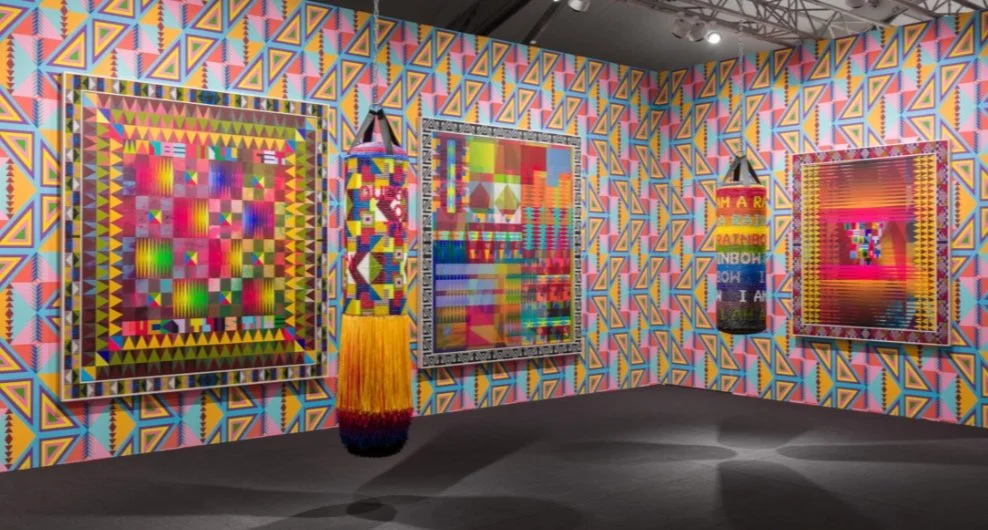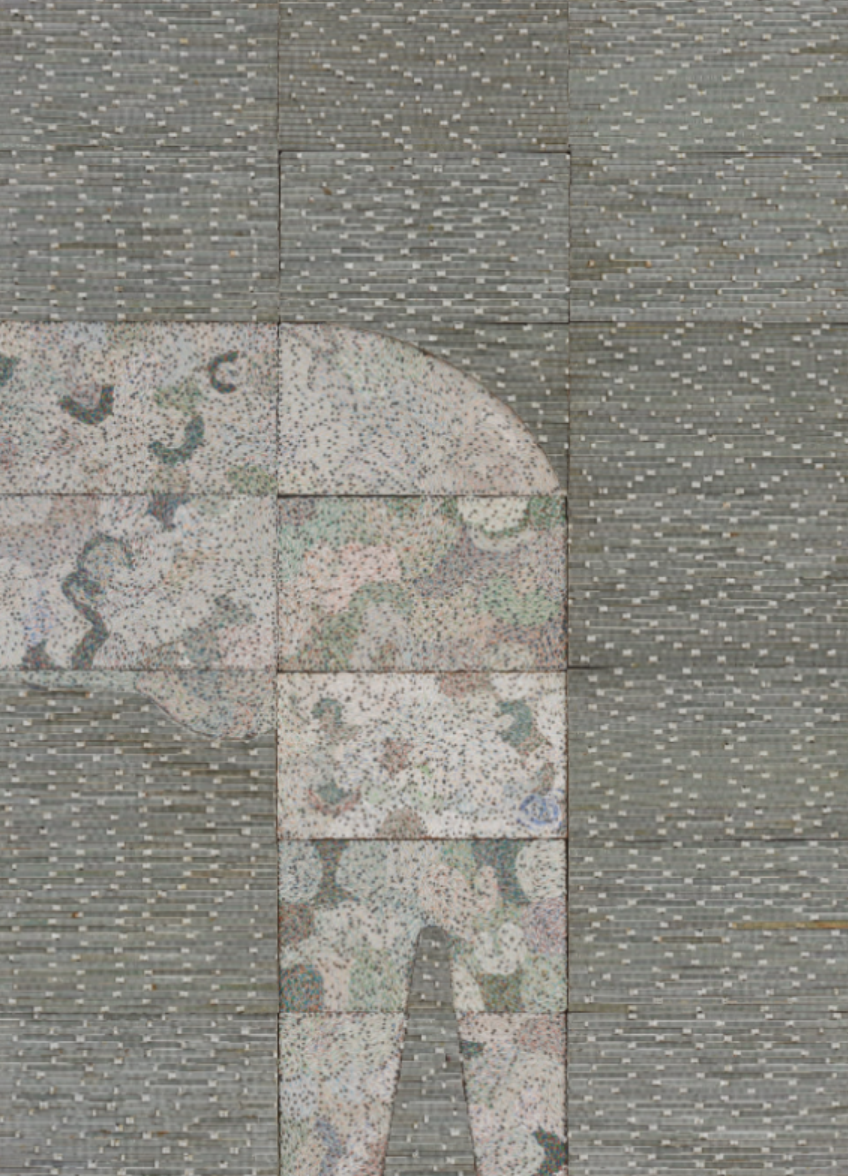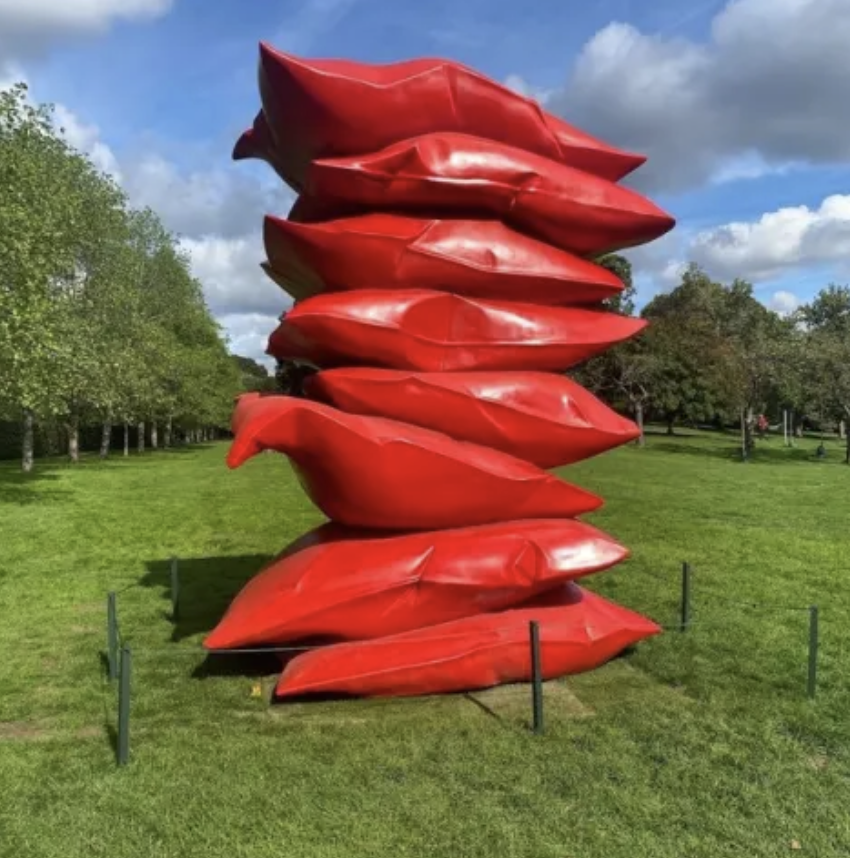ART BUYING IN THE UK
OCTOBER 2022
Last week London was inundated with collectors and art enthusiasts attending the Frieze fair, the Big Three auction houses, and various gallery openings about town. Americans, largely absent last year were taking advantage of the strong dollar before heading to Paris and the anticipated Paris + fair later this week for back-to-back shopping. Despite the long "queue" on the opening VIP day of Frieze, sales and attendance were robust, and the main tent, Sculpture park, and Masters area were all teeming with buyers.
Below are some highlights that caught our eye.
ALEXANDRE LENOIR
Alexandre Lenoir is the emerging Parisian painter you need to know about. He is a French-Caribbean artist, whose paintings consist of multiple layers of color, combined with an elaborate technique of stenciling. Representing landscapes of luxurious vegetation, interiors and buildings, Lenoir’s works often include characters as ephemeral as memories.
Working in the dark, Alexandre's images are consciously out of focus, which only serves to add to their effect. He prepares his canvases by covering the subjects with tape and then painting all around them with acrylics and oils. This technique of taping up certain areas while painting over exposed surfaces is repeated multiple times to build various color separations. Finished works can contain anywhere from 20 up to 100 coats of paint and thousands of pieces of masking tape.
Alexandre Lenoir was awarded the Fondation Jean-François Prat et Marie-Laure de Clermont-Tonnerre in 2016 and Pierre Cardin de l’Académie des Beaux-Arts de Paris prizes in 2020.
RAJKAMAL KAHLON
We’ve Come a Long Way to be Together is a series of portraits of travelers from Africa, Asia and the Middle East painted on top of the pages of a cut-out and reassembled 1st edition copy of Wilfred Thesiger’s Arabian Sands. Wilfred Thesiger was an English explorer and travel writer (1910 -2003). Arabian Sands, published in 1959, recounts his travels in the Empty Quarter of Arabia, (Rub'Al Khali) between 1945 and 1950. It is considered a classic of travel writing. The portraits aim at disrupting conventional ways of seeing how we travel and highlight the highly ideological representations equated with refugees and migration contrasted against European exploration and tourism.
By appropriating a range of archival materials in her work - anthropology and travel books, historical treatises, medical records and military reports - the artist confronts the problematic nature of her sources overlaying contemporary imagery and poignant portraiture atop the disassembled book pages. Through her visual address, she questions the narratives contained within these materials and reveals the racist subtexts and objectifications of the ethnic body found within.
Born in 1974 in Northern California, Rajkamal Kahlon is currently based in Berlin, Germany. She received her Bachelor of Fine Arts from the University of California, Davis, and a Master of Fine Arts in Painting and Drawing from the California College of Arts. She is an alumna of Skowhegan School of Painting and Sculpture and the Whitney Independent Study Program in New York. Her work has been exhibited internationally at the 2012 Taipei Biennial; Haus der Kulturen der Welt, Berlin; the Museum of Contemporary Art, Antwerp; the Museum of Modern Art, Warsaw; and the Museo Universitario de’Arte Contemporaneo, Mexico City.
GAHEE PARK
GaHee Park’s paintings may recall the style of painters like Henri Rousseau, but her subject matter is far different. Often depicting romantic scenes that have turned sour, the acts that seem to be transpiring in her paintings are at odds with their quaint settings. Her surreal paintings and drawings offer illicit glimpses of intimate moments and erotic fantasies. Exploring themes of desire, pleasure, and the division between public and private, her canvases portray entangled couples and solitary nude women, often set in domestic interiors. The artist fills her lush scenes with uncanny details—limbs are detached or too long, for example, while some subjects are fragmented by mirrors, furniture, and windows. Often, a figure lurks near the central scene, adding a sense of voyeurism to the composition.
Park’s unabashedly erotic canvases reject both the sexual repression of the artist’s strict Catholic upbringing and the sexist depictions of women in the art historical canon. Park was born in 1985 in Seoul, South Korea and currently lives and works in Montreal, Canada. She received her BFA from the Tyler School of Art and earned her MFA in painting from Hunter College in 2015.
CHASE HALL
Chase Hall’s paintings and sculptures respond to generational celebrations and traumas encoded throughout American history. In a powerful, major new work, he addresses ideas about togetherness, sameness and difference, and the relationship between individual aspiration and collective vision. God is You (2022), seen here, executed on two panels with a variety of materials, exemplifies both the reach and the intimacy for which Hall has become recognized. The image is based on an archival photograph of a Baptist conference where people from many states gathered—a social heterogeneity that the artist addresses in physical terms by affixing enamel lapel pins from his own collection to the work. The use of the pins not only imparts real-world presence to the scene he depicts, but also introduces a new kind of visual and sculptural immediacy to a painterly vocabulary that is always attuned to nuances of color, texture, and geometry.
Additionally, the use of brewed coffee carries powerful symbolic weight since it evokes centuries-old geopolitical systems associated with the commodification of a plant native to Africa, but in Hall’s hands, it also becomes a means of achieving subtle visual textures, a range of brown skin tones, and a mark-making vocabulary precipitated on the closeness of touch.
Hall was born in 1993 in St. Paul, Minnesota. He was commissioned by the Metropolitan Opera to produce a large-scale artwork for its opera house in New York. His monumental diptych, Medea Act I & II (2022), is on view at the Met Opera through June 2023. Hall’s work is in the permanent collections of institutions including the Los Angeles County Museum of Art; Institute of Contemporary Art, Miami; Fondation Louis Vuitton, Paris; Baltimore Museum of Art; Brooklyn Museum, New York; Hammer Museum, Los Angeles; High Museum of Art, Atlanta; Montreal Museum of Fine Arts; Walker Art Center, Minneapolis; The Studio Museum in Harlem, New York; and Whitney Museum of American Art, New York.
JEFFREY GIBSON
Jeffrey Gibson’s work fuses his Choctaw-Cherokee heritage with references that span club culture, queer theory, fashion, politics, literature and art history. The artist’s multi-faceted practice incorporates painting, performance, sculpture, textiles and video and is characterized by vibrant color and pattern.
Six new mixed-media paintings, two large beaded punching bag sculptures and a beaded bust were included in his solo-booth exhibition. In these works, Gibson combines Indigenous artisanal handcraft – such as beadwork, leatherwork and quilting – with narratives of contemporary resistance in protest slogans and song lyrics. The artist harnesses the power of these materials to activate overlooked narratives, while embracing the presence of historically marginalized identities.
Pop music is also one of the primary points of reference in Gibson’s practice. His paintings synthesize geometric patterns inspired by North American Indigenous aesthetic histories with the lyrics and psychedelic palette of disco music.
The artist features in collections around the world including The Museum of Modern Art, Smithsonian Institution, Whitney Museum of American Art and National Gallery of Canada.
ELIAS SIME
Ethiopian artist Elias Sime showcased works from his ongoing Tightrope series. The artist deftly weaves, layers and assembles materials into abstract compositions that suggest topography, figuration, and sublime color fields. The history of his materials hold meaning, as they are the backbone of all communication systems, whether they be telephone or computer. They suggest the tenuousness of our interconnected world, alluding to the frictions between human contact and social networks, nature and the man-made, and physical presence and the virtual.
Sime was selected to participate in the 59th Venice Biennale this year. In 2019, he received an African Art Award from the Smithsonian National Museum of African Art and was shortlisted for the Hugo Boss Prize 2020.
Elias Sime’s work is included in the permanent collection of the Metropolitan Museum of Art, NY; Detroit Institute of Arts, MI; Israel Museum, Jerusalem, Israel; Kemper Museum of Contemporary Art, Kansas City, MO; Newark Museum, Newark, NJ; Norval Foundation, Cape Town, South Africa; Pérez Art Museum Miami, Miami, FL; Pizzuti Collection at the Columbus Museum of Art, Columbus, OH; Saint Louis Art Museum, St. Louis, MO; Toledo Museum of Art, Toledo, OH; Utah Museum of Fine Arts, Salt Lake City, UT; Virginia Museum of Fine Arts, Richmond, VA; 21st Century Museum of Contemporary Art, Kanazawa, Japan., among others.
HAYLEY BARKER
Hayley Barker is a Los Angeles based painter whose nuanced landscape and nature paintings strike a seemingly impossible harmony between intimacy and grandeur. Her subjects are sometimes explicitly rendered from life – the tree from her bedroom window, the view across her lovingly tended yard, or the plants on her windowsill – and yet they seem to come from an interior place, balancing real and imaginary worlds in works that suggest as much a dreamscape as a landscape.
Technically, they present a contradiction, seemingly dense, almost claustrophobic, in the way they are worked and yet full of space, color and light. Dryly painted with fine brushes, often on raw linen allowed to show through, they seem intensely personal and yet invitingly universal.
Barker received her BA from the University of Oregon, and her MA & MFA in Intermedia from the University of Iowa.
CLARE WOODS
Originally trained as a sculptor, the paintings by Clare Woods are essentially concerned with sculpting an image in paint and expressing the peculiarities of an object. Much of Woods’ work is an exploration of physical form. This understanding of sculptural language and a preoccupation with forms in space, translated into two-dimensional images, underpins her pictorial practice.
Woods was born in 1972 in Southampton, UK. She has a BA in Fine Art from Bath College of Art and an MA in Fine Art from Goldsmith’s College, London. Her work is held in numerous public collections including Albright-Knox Art Gallery, Buffalo; Arken Museum of Modern Art, Denmark; Arts Council Collection, London; CCA Andratx, Mallorca, Spain; Government Art Collection; and The National Museum of Wales, Cardiff.
RASHID JOHNSON
Rashid Johnson's mirrored tile works address emotional and psychological extremes with abrupt directness. Throughout this older series, the order and geometry of the mirrored grids provide a support for the improvised monumentality of energetic marks made with poured, splattered, and scratched black wax. As its title suggests, Facts (2012) exemplifies what Johnson achieves when he fully embraces his instinct for abstraction within a conceptual frame-work that alludes to the pressures and possibilities of the external world. The zip-like pour that defines the composition’s central axis is a potent symbol of individuality, and, in both literal and metaphorical terms alike, of the power of gravity on all things.
The complex geometry of the mirrored tiles reflects both the image of the viewer and the space in which they stand. The work also gets to the core of Johnson’s approach to materials and process. The artist uses materials that have a metaphorical and symbolic resonance for him, including products familiar from his childhood, such as West African herbal soap blackened with ash. Johnson grew up in Chicago during the 1970s and 80s, surrounded by his family’s early Afrocentrism, which dictated that many of the household’s objects should be symbols of “applying an Africanness to one’s self”. However, as his family moved into a more middle-class, professional neighborhood, Johnson felt increasingly dislocated from the Afrocentric space that had been nurturing him since birth.
This series is a testament to Johnson’s ongoing relationship with everyday objects that double up as signifiers for a culture. The mirror, blackened parts negate the reflective nature of its surface and function as an abstraction on identity. Johnson, caught in a state of social flux, questions his own place in a shared lineage of black history, identity and art. His work often contemplates his own relationship with the pioneering cultural figures who came before him.
DANIEL ARSHAM
Daniel Arsham’s aesthetics revolve around his concept of fictional archaeology. Working in sculpture, architecture, drawing and film, he creates and crystallizes ambiguous in-between spaces or situations, and further stages what he refers to as future relics of the present. They are eroded casts of modern artifacts and contemporary human figures, which he expertly makes out of some geological material such as sand, selenite or volcanic ash for them to appear as if they had just been unearthed after being buried for ages. Always iconic, most of the objects that he turns into stone refer to the late 20th century or millennial era.
Arsham was born in 1980 in Cleveland, Ohio and currently lives and works in New York. Arsham studied at Cooper Union in New York and has exhibited in New York, Paris, Tokyo, Shanghai, Los Angeles, London, and beyond. His work resides in the collections of the Musée Guimet, the National Gallery of Victoria, the Pérez Art Museum Miami, and the Institute of Contemporary Art, Miami, among others. In addition to his fine art practice, Arsham has collaborated with a number of brands, including Adidas, Dior, and Porsche, and he has worked with the Cleveland Cavaliers basketball team as creative director.
BARTHELEMY TOGUO
Barthélémy Toguo addresses enduring and immediately relevant issues of borders, exile, and displacement. At the core of his practice is the notion of belonging, which stems from his dual French/Cameroonian nationality. Through poetic, hopeful, and often figural gestures connecting nature with the human body, Toguo dispatches concerns with both ecological and societal implications. Recently, his works have been informed by movements and humanitarian tragedy including #BlackLivesMatter and the refugee crisis.
This past year, Toguo was commissioned for a monumental site-specific installation The Pillar of Missing Migrants under the Louvre Museum's pyramid in Paris, France. His works are included in public collections worldwide, including the Tate Modern, England; Centre Pompidou, France; Musée d'art contemporain de Lyon, France; Studio Museum Harlem, New York; and MoMA, New York. In 2011, Toguo was made a Knight of the Order of Arts and Literature in France. He currently lives and works between Paris, France and Bandjoun, Cameroon.
PEJU ALATISE
Péju Alatise is an interdisciplinary artist, architect, and writer. She produces works across a variety of mediums, including but not limited to paintings, film, installations, sculptures. Péju’s work is pointedly political, often asking questions of the times and the state of affairs at home and abroad. Situated in Regent's Park, Sim and the Glass Birds is the latest installment of the artist’s career-long preoccupation with exploring the world of marginalized young girls through ambitious sculptural representation, Yoruba mythology and folklore. It is the visual response to a story Alatise herself wrote about a young girl who constantly escapes to a dream world where she is safe and finds rest, away from the troubles of an earthly world that cages her ambitions, relegates her to inferior citizenship, and declares she has no rights. Yoruba mythology is filled with stories of gods and creatures with powers commanding thunder, water, retribution, and abundance whose purpose for being is to protect and provide. It is in this dreamscape told through folklore and stories that Sim finds solace, and which Alatise uses as a point of departure for her sculptures.
In this four-panel installation, fabricated out of cast granite, stainless steel, and glass, the character Sim is suspended in this dreamscape, crossing a portal between Earthly life and the other world. She is in the company of foreboding and mythological creatures — glass birds in flight — which are caught over the panels and which will eventually break. Its delicate nature is a metaphor for the fleeting nature of escape in itself and its inevitable, unfortunate end.
SHAIKHA AL MAZROU
Shaikha Al Mazrou’s sculptures are expressions of materiality—articulations of tension and the interplay between form and content. Central to her practice is her use of material and its apparent contradictions, using durable materials that are made to resemble something soft and pliable.
Fascinated by notions of physical space, Al Mazrou’s sculptures and installations materialize as simple gestures that emphasize the representation of tension, weight and space, while borrowing formally from minimalism and intellectually from conceptual art, color theory and geometric abstraction. Her Red Stack in Regent's Park resembles helium balloons or giant displays of origami.
Shaikha Al Mazrou was born in the UAE in 1988 and received her MFA in 2014 from the Chelsea College of Fine Art, University of the Arts London. Prior to that she studied at the College of Fine Arts and Design, University of Sharjah. She is currently a visiting assistant professor at New York University, Abu Dhabi. She lives and works between Dubai and Abu Dhabi.













